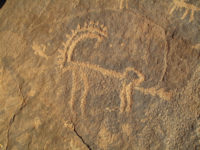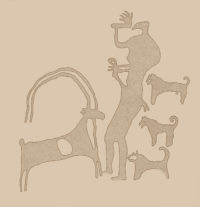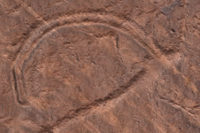Blog Archives
-
Ibex
The ibex is similar to the wild goat in terms of the shape of its head, body, and tail. Like the goat, it has scimitar horns that curve backward in a large semi-circle, but with the addition of a series of regularly spaced transverse ridges along the outer edge of the curve. Ancient artists depicted these ridges distinctly on the more realistic panels, however, where a caprine [...]
-
Jubbah Woman Detail: Ibex
Click here to download the PTM file. Desktop RTI viewers can be downloaded from Cultural Heritage Imaging.
-
Hoodoo, Bir Hima
A delicately balanced block of sandstone (or hoodoo) at the top of this hill attracted the attention of ancient artists in southern Saudi Arabia.
-
Shuwaymis East, Camel Panel
These camel petroglyphs are much more recent than the Neolithic petroglyphs found on the west side of the valley at Shuwaymis. Here, the full beauty of the panel is illuminated by the setting sun.
-
Chariot and Horses (detail), Jubbah
This style of depicting a chariot and its team of horses in plan view is distinctive and unique for Saudi Arabia.
-
“The King,” Jubbah
Located a short walk from the "Eagle's Nest" panel of petroglyphs at Jubbah, this unique panel shows a large, atypically realistic figure of a male, who has been interpreted as a king or other person of authority.
-
Equine hunting scene at Shuwaymis
This Neolithic petroglyph, which can be found on the western side of the Shuwaymis locality, is a hunting scene in which a bow hunter and his pack of dogs prepare to dispatch an African wild ass or onager.
-
Al Naslaa, Tayma
Al Naslaa is one of the most photogenic petroglyphs we have seen. The uniform slit between the two standing stones and the flat faces are completely natural.









